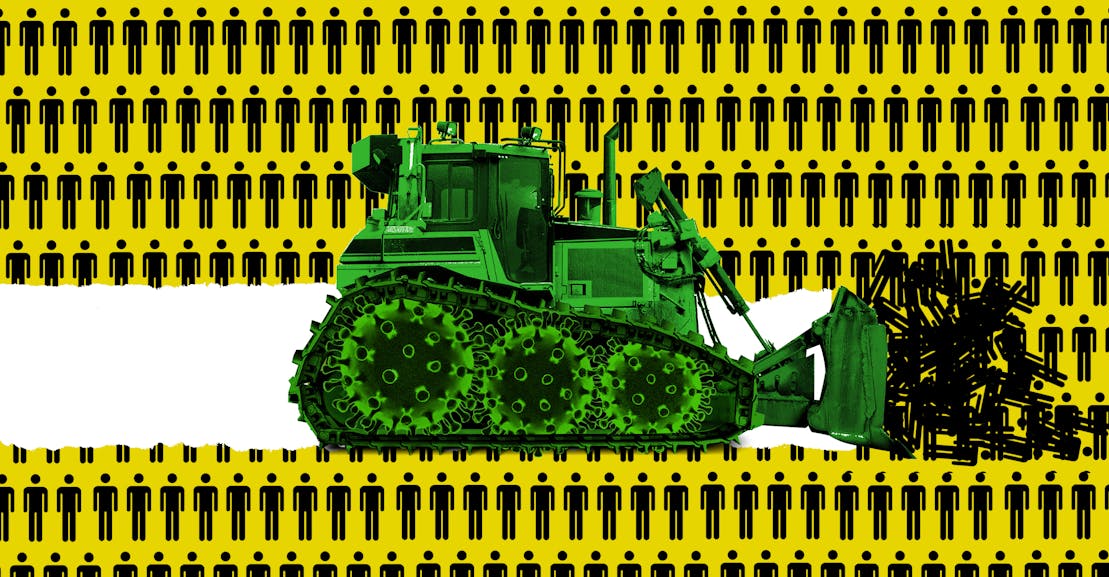Even in an age of social distancing, you’ll still find the strangest people getting into bed with each other. In mid-March, the U.K. government’s behavioral insights team—known as the “nudge unit”—unveiled its response to tackling the novel coronavirus. Its plan, as is well known now, involved allowing the disease to run through the population in order to develop local herd immunity. The nudge unit’s rationale was that most of those infected would recover and develop a natural resistance to the virus, which would slow the spread of the disease among the most vulnerable as the search for a vaccine continued. The British nudgeocrats did not flinch at the implication that this strategy, given the virus’s known mortality rates, could eventually kill between a quarter- and a half-million people: effectively a form of state-sanctioned mass murder.
In response to the predictable outcry, the U.K. government eventually changed course and embraced social distancing and other mobility-limiting measures to flatten the viral infection curve. But the death drive at the heart of the herd immunity strategy did not fade with the defeat of the nudgeocrats’ preferred approach. As lockdowns took hold and the full economic toll of the pandemic grew apparent, calls across the developed world to “get back to work” and more carefully evaluate the costs and benefits of social distancing increased. At the start, this was usually framed as a choice between lives and dollars: “No society can safeguard public health for long at the cost of its economic health,” editorialized The Wall Street Journal on March 19, while an opinion column in Australia asked, “Lives matter, but at what cost?” Eventually, these calls became more straightforwardly eliminationist, presenting the slaughter of those most at risk from the virus as a form of heroic wartime sacrifice. In an emblematic exchange, 70-year-old Texas Lieutenant Governor Dan Patrick told Tucker Carlson he would be prepared to risk death if it would allow the economy to return to normal.
This strain of eliminationism is not simply a derangement of the political right; the notes sounded by the dollars versus deaths brigade come straight from the liberal hymnbook. Cass Sunstein, Obama administration regulator and patron saint of the nudgeocrats, got in early with his own gratingly contrarian pandemic take. “Probability neglect,” he announced in late February with a characteristic cod-social-scientific flourish, meant “a lot of people are more scared” about the coronavirus “than they have any reason to be.” Libertarians quickly followed suit, among the most prominent of them law professor Richard A. Epstein and economist Robin Hanson, who pushed for the adoption of strategies centered around “voluntary infection” and “variolation” as alternatives to social distancing. A common thread united these approaches: the idea that, sometimes, life is simply not worth fighting for. “It is not always unacceptable to cause death knowingly,” Sunstein wrote in one of the four books he published last year. “When government allows new highways to be built, it knows that people will die on those highways.” For a liberal cost-benefit fanatic like Sunstein, policy is always about trade-offs, even when the costs can be measured in lost lives; do we really want to stop building highways just because some people will die on them? Since the value of a human life can be quantified—at $9 million to $10 million, according to major federal agencies—death is acceptable, and lives expendable, when more valuable goods are involved. The coronavirus pandemic has breathed new life into this old utilitarian chestnut, and it is precisely the life-reducing mindset of cost-benefit analysis that has driven the resistance to social distancing.
What’s remarkable is how voices conventionally thought to occupy opposite ends of the political spectrum have latched on to the cause of acceptable death. Cheering for the elimination of humans is now an authentically pan-political concern. “Wow,” a Silicon Valley product designer tweeted in mid-March. “Earth is recovering. Air pollution is slowing down. Water pollution is clearing up. Natural wildlife returning home. Coronavirus is Earth’s vaccine. We’re the virus.” That catchphrase (“We are the virus”) has been widely mocked and memed, and while there are many in the environmental movement who take issue with its basic premise—that humans, rather than resource use or consumer capitalism, are the problem—plenty of others have responded in vigorous agreement. In one of the more interesting contributions to this school of thought, Canadian ecologist William E. Rees connected the pandemic to climate change, characterizing both as the result of a single factor: rampant population growth. “There are no exceptions to the first law of plague dynamics: the unconstrained expansion of any species’ population invariably destroys the conditions that enabled the expansion, thus triggering collapse,” Rees wrote in early April. The only way to “salvage global civilization,” he insisted, is by reducing “the human ecological footprint” through a “controlled contraction of the human enterprise.” In other words, we must depopulate or perish. Fewer people will be our salvation.
